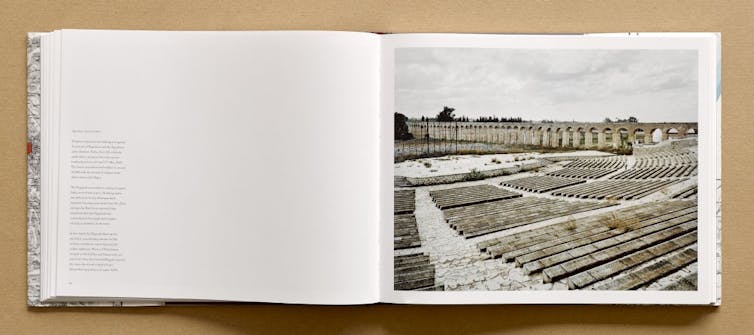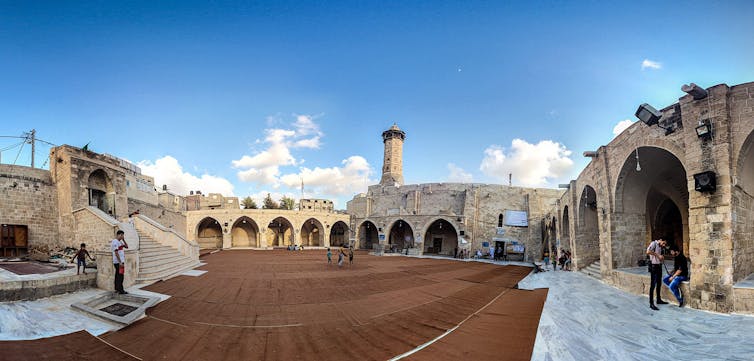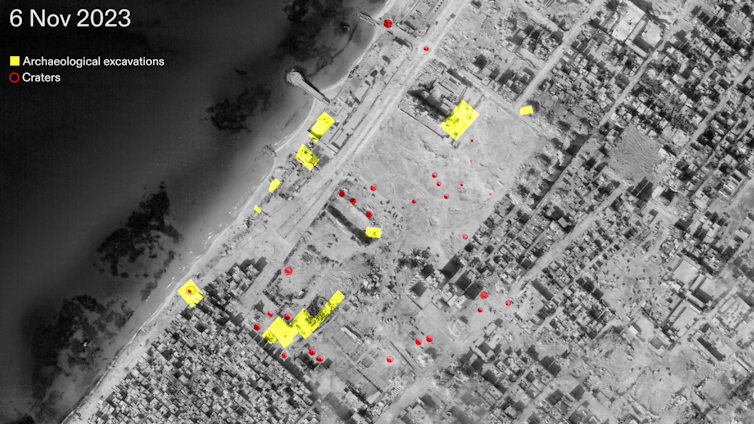
In 2016, British photographer James Morris published Time and Remains of Palestine. The images in this book bear witness to an absence of architectural monuments, and to the invisible moments of history buried in the rubble and wastelands of Palestine.

Situated at the crossroads between Asia and Africa, Palestine has always been an area of great strategic importance, and it has been populated by various civilisations throughout history. Its emptiness can therefore only be explained by a false history, one that stems directly from the Israeli settler movement, which seeks to destroy the material traces of other cultures that point to a much more complex past than they would like to admit.
This complexity has been painstakingly proven in a Forensic Architecture report on an archaeological site known as Anthedon Harbour, Gaza’s old maritime port, which was first inhabited somewhere between 1100BC and 800BC.
October 2023: human cost takes precedence over cultural losses
On 7 October 2023, the day after the 50th anniversary of the Yom Kippur war, Israelis celebrated the Simchat Torah holiday. While this was happening, the wall built by Israel inside the Gaza Strip was breached by more than 1,200 Hamas members in a surprise attack. They kidnapped more than 200 people, and left at least 1,200 dead and almost 3,500 injured.
Israel swiftly declared a state of war for the first time since 1973. The conflict, which has just passed its one year mark, has become an unprecedented humanitarian catastrophe for 2.3 million Palestinians. The numbers are appalling: over 41,000 dead, including more than 14,000 children, almost 100,000 wounded and more than two million displaced.
A month after the outbreak of the war, UNESCO, at its 42nd General Conference, stated that “the current destruction and eradication of culture and heritage in Gaza is yet to be determined, since all efforts are now being concentrated on saving human lives in Gaza.”
Leer más: The destruction of Gazaʼs historic buildings is an act of 'urbicide'
Monitoring the disaster
The scale of Gaza’s humanitarian catastrophe has meant that the extensive destruction of significant elements of Palestinian history and identity could easily be overlooked. However, in April 2024, the United Nations Mine Action Service estimated that “every square metre in Gaza impacted by the conflict contains some 200 kilogrammes of rubble.”
Cultural property has been a target of the Israeli offensive since the beginning of the conflict and, as early as November, the devastation of the cities of northern Gaza far exceeded that caused in the infamous bombing of Dresden in 1945. We cannot forget that the Gaza Strip is just a narrow area of coastal land measuring some 365 km², rich in archaeological and historical sites, that the international community has recognised as occupied territory since 1967.
Research over the last century has counted at least 130 sites in Gaza that Israel, as an occupying power, is obligated to protect under international law along with the rest of the area’s cultural and natural heritage. These obligations are laid out in the following conventions: Convention on the Prevention and Punishment of the Crime of Genocide (1948); the Geneva Conventions (1949) and their annexes, and the Hague Convention for the Protection of Cultural Property in the Event of Armed Conflict (1954).
As of 17 September 2024, UNESCO has verified damage to 69 sites: 10 religious sites, 43 buildings of historical and artistic interest, two repositories of movable cultural property, six monuments, one museum and seven archaeological sites. Other reports give a much higher number of affected sites. These assessments are made in very difficult situations, in the midst of constant bombardment, thanks to testimonies and studies on the ground and supported by satellite images.

One especially striking example of a site reduced to rubble is the Great Mosque of Gaza, considered by many to be the oldest mosque in the territory and a symbol of resilience. The Church of Saint Porphyrius – the oldest Christian church in Gaza, built by the Crusaders in 1150 – has also been hit by Israeli airstrikes.
While Israel is not a member of UNESCO – it left in 2018, when the Trump administration pulled the US out – it is still obligated under the 1954 Hague Convention to preserve cultural property. Article 4 of the Convention states that:
“The High Contracting Parties undertake to respect cultural property situated within their own territory as well as within the territory of other High Contracting Parties by refraining from any use of the property and its immediate surroundings or of the appliances in use for its protection for purposes which are likely to expose it to destruction or damage in the event of armed conflict; and by refraining from any act of hostility, directed against such property. ”
The Hague Convention turned 70 in 2024, but cultural heritage sites are still woefully underprotected from armed conflict around the world.
Humanitarian and cultural genocide
The destruction of Gaza’s cultural heritage is intertwined with the ongoing humanitarian crisis. This link is recognised by the International Criminal Court, which states that:
“Crimes against or affecting cultural heritage often touch upon the very notion of what it means to be human, sometimes eroding entire swaths of human history, ingenuity, and artistic creation.”
Many independent reports and articles have begun to break down specific elements of the destruction in Gaza, speaking not just of genocide, but also of cultural genocide, urbicide, ecocide, domicide and scholasticide.
Leer más: The war in Gaza is wiping out Palestine's education and knowledge systems
On 29 December 2023, the Republic of South Africa brought a case before the International Court of Justice, accusing Israel of violating its obligations under the 1948 Convention on Genocide with regard to Palestinians in Gaza.
Among the evidence supporting South Africa’s claim, Israel is accused of attacking infrastructure to bring about the physical destruction of the Palestinian people, with their attacks leaving some 318 Muslim and Christian places of worship in ruins, along with numerous archives, libraries, museums, universities and archaeological sites. This is all in addition to destroying the very people who created Palestine’s heritage.
Gaza: one big military target
In her report, published on 1 July 2024, Francesca Albanese, the UN Special Rapporteur on the situation of human rights in the Palestinian territories, highlights how Israel has turned Gaza in its entirety into a “military target”. The Israeli military arbitrarily links mosques, schools, UN facilities, universities and hospitals to Hamas, thus justifying their indiscriminate destruction. By declaring these buildings legitimate targets, it does away with any distinction between civilian and military targets.

Although Israel’s attacks against the cultural heritage of Palestine are not a new phenomenon, the current destruction in Gaza’s city centres is unprecedented.
As far as Albanese is concerned, Israel is trying to mask its intentions by using the terminology of international humanitarian law. In doing so, it justifies the systematic use of lethal violence against any and all Palestinian civilians, while simultaneously pursuing policies aimed at the widespread destruction of Palestinian cultural heritage and identity.
Her report unequivocally concludes that the Israeli regime’s actions are driven by a genocidal logic, a logic that forms an intrinsic part of its colonisation project. Its ultimate aim is to expel the Palestinian people from their land, and to wipe away any trace of their culture and history.
Pilar Montero Vilar no recibe salario, ni ejerce labores de consultoría, ni posee acciones, ni recibe financiación de ninguna compañía u organización que pueda obtener beneficio de este artículo, y ha declarado carecer de vínculos relevantes más allá del cargo académico citado.
This article was originally published on The Conversation. Read the original article.







